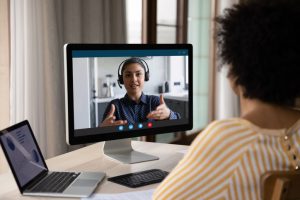 VP ViedoPhone for Deaf Community
VP ViedoPhone for Deaf Community
Videophone (VP) at Our Office for the Deaf Community
If we go to the past, there were only limited options for the deaf community to communicate with their friends and family. But after the invention of the Videophone, it has become easy for the deaf community to attend business meetings.
Due to the increasing demand for VideoPhone, we also have a Videophone (VP) at our office for the deaf community. In fact, almost every business needs to have it in their office. So, in this article, we’ll discuss what a Videophone is and how it works. So, let’s start.
What Is Videophone?
It’s a device for deaf people who use sign language to communicate with others. Deaf people can use it to communicate over the phone. Moreover, they can use it to communicate with hearing people by using a sign language interpreter. It’s also called VP. Many companies in the USA provide these Videophones plus interpretation services to deaf people.
VP technology is changing rapidly, so the best practice is to check VP services so that you can get the right one for your needs.
We offer VideoPhone (VP) at our office for the Deaf Community. Our number is VP-689-240-6640
How Does Videophone Work?
It’s pretty simple to set up and use a videophone. You’ll need an internet connection & a screen to connect with VP. Deaf people can have an application on their smartphones. Other people also need to have the same application to get started. Nowadays, many communication companies are also offering VP.
Many translations and interpretation companies provide videophones. Moreover, they have their own equipment, procedures, and technicians to monitor all the operations. So, now Videophone (VP) at our office for the deaf community is the need of everyone.
Contact a professional Company like Verbatim Languages for videophone services at your office. We will not only provide videophones, but we’ll provide support and technicians as well. So, you can get our services for the deaf community.
How Can Deaf People Use Videophones to Communicate?
Deaf people can use VP for communication in two ways:
Direct Communication
For this type of communication, both people must have a VP. In this way, they don’t need any relay service, and they can start calling each other. But in direct communication, there are chances of glitches, such as a disconnection may occur, the picture might be blurred, and the camera may freeze. Hearing people can also face these issues when they use any phone system for a video call.
Relay Interpreter for Communication
If the deaf wants to communicate with a hearing person, they need an interpreter, and the interpreter must have a compatible device. So, companies providing interpretation services use relay interpreters. The interpreter must have ASL competency to be able to work for an interpretation and Translation Company.
If two deaf people want to communicate, but only one has VP, the second one will have to get it from an agency, local library, or a company. In simple words, if two people want to communicate visually, both of them must have a videophone.
We have a Videophone (VP) at our office for the deaf community; if you also want to get one, you’re at the right place.
Posted on